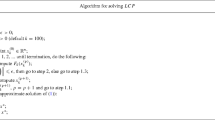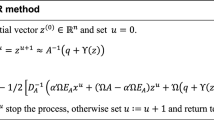Abstract
We propose a two-stage successive overrelaxation method (TSOR) algorithm for solving the symmetric linear complementarity problem. After the first SOR preprocessing stage this algorithm concentrates on updating a certain prescribed subset of variables which is determined by exploiting the complementarity property. We demonstrate that this algorithm successfully solves problems with up to ten thousand variables.
Similar content being viewed by others
References
P.E. Gill and W. Murray, “Methods for large-scale linearly constrained problems,” in: Gill and Murray, eds,Numerical Methods for Constrained Optimization (Academic Press, London and New York, 1974) pp. 93–148.
D. Goldfarb, “Extensions of Newton's method and simplex methods for solving quadratic programs,” in: Lootsma, ed.,Numerical Methods for Non-Linear Optimization (Academic Press, London and New York, 1972) pp. 239–254.
S.C. Hoyle, “A single-phase method for quadratic programming,” Systems Optimization Laboratory, Technical Report #8609, Stanford University (Stanford, CA, 1986).
M.L. Lenard, “A computational study of active set strategies in nonlinear programming with linear constraints,”Mathematical Programming 16 (1979) 81–97.
D.P. Bertsekas, “Projected Newton methods for optimization problems with simple constraints,”SIAM Journal of Control and Optimization 20 (1982) 221–246.
O.L. Mangasarian, “Solution of symmetric linear complementary problems with iterative methods,”Journal of Optimization Theory and Applications 22 (1977) 465–484.
O.L. Mangasarian and R. De Leone, “Parallel gradient projection successive overrelaxation for symmetric linear complementarity problems and linear programs,”Annals of Operations Research 14 (1988).
R. De Leone, O.L. Mangasarian and T.-H. Shiau, “Multi-sweep asynchronous parallel successive overrelaxation for the nonsymmetric linear complementarity problem,”Annals of Operations Research 22 (1990) 43–54.
R. De Leone and O.L. Mangasarian, “Asynchronous parallel successive overrelaxation for the symmetric linear complementarity problem,”Mathematical Programming, Series B, 42 (1988) 347–361.
R. De Leone and O.L. Mangasarian, “Serial and parallel solution of large scale linear programs by augmented Lagrangean successive overrelaxation,” in: Kurzhanski, Neumann, Pallaschke, eds.,Optimization, Parallel Processing and Applications, Proceedings of the Oberwolfach Conference on Operations Research, February 16–21, 1987 and the Workshop on Advanced Computation Techniques, Parallel Processing and Optimization, February 22–25, 1987 (Springer-Verlag, 1987) pp. 103–123.
Author information
Authors and Affiliations
Additional information
This material is based on research supported by National Science Foundation Grants DCR-8420963 and DCR-8521228 and Air Force Office of Scientific Research Grants AFSOR-86-0172 and AFSOR-86-0255 while the author was at the Computer Sciences Department at the University of Wisconsin-Madison, USA.
Rights and permissions
About this article
Cite this article
Medhi, K.T. A two-stage successive overrelaxation algorithm for solving the symmetric linear complementarity problem. Mathematical Programming 65, 365–380 (1994). https://doi.org/10.1007/BF01581703
Received:
Revised:
Issue Date:
DOI: https://doi.org/10.1007/BF01581703




